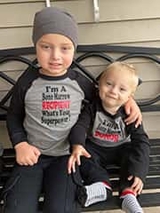X-linked Lymphoproliferative Disease 1: Rafi’s Story
X-linked Lymphoproliferative Disease 1: Rafi’s Story
Ever since 5-year-old Rafi was a baby, he would get sick every few weeks. Doctors initially advised it wasn’t anything to worry about, but the intuition of his parents, Dina and Dovi, brought them to Children's Hospital of Philadelphia’s (CHOP) immunology team. Genetic sequencing revealed an unexpected diagnosis. After a bone marrow transplant, Rafi is healthy, thriving and looking forward to school in the fall.

Pediatricians initially attributed Rafi’s constant stream of viruses and infections to him being in daycare and exposed to other children. Unsatisfied with this answer, Dina and Dovi brought Rafi to see a long roster of specialists near their New Jersey home, from allergists to pulmonologists. “This often yielded the explanation that Rafi will simply ‘grow out of it,’” says Dovi. But when Rafi spiked a 105-degree fever while at the pediatrician’s office, the doctor suggested seeing an immunologist — one who specializes in pediatrics. The family turned to CHOP.
They met with CHOP immunologists, including Sarah Henrickson, MD, PhD, an expert in primary immune deficiency and immune dysregulation. “She took time to learn about Rafi’s story and what brought us to her,” says Dovi. Initially Rafi was found to have differences in his ability to make good responses to vaccines, but his immune state become more complicated over time. At first, Dr. Henrickson thought that these results could point to a condition called common variable immune deficiency (CVID). She discussed considering intravenous immunoglobulin therapy, but she and the family decided to keep monitoring Rafi.
After continued surveillance, Rafi’s immunoglobin levels began to appear to normalize, but a normalization of these levels is not commonly seen in a CVID patient. And so, to leave no stone unturned and to ensure that nothing was missed, Dr. Henrickson asked if the family would be comfortable undergoing genetic sequencing — a study that is complex and takes several months for results to return.
Almost never detected prior to symptoms
Dr. Henrickson saw Rafi’s clinical condition in the context of family history of other immune issues as sufficient reason to suggest the genetic sequencing. In December 2020 at CHOP, Dina, Dovi and Rafi had blood drawn. The results of the sequencing were alarming: Rafi had a very rare and potentially fatal genetic disease called X-linked lymphoproliferative disease 1 (XLP1). With this condition, the immune system overreacts when exposed to certain viral infections, which can lead to life-threatening complications. XLP1 is almost never detected prior to the onset of severe symptoms, and discovering it at this stage in Rafi, when he was still generally healthy, was extraordinarily beneficial. The only cure for XLP1 is a bone marrow transplant.
The genetic change that causes XLP1 is on the X chromosome, and because boys have only one X chromosome, XLP1 almost exclusively affects boys. Only about 1 male in 1 million has XLP1, and many don’t live into their teens. “We did expedited genetic sequencing on our other two boys,” says Dina. Neither one had the mutation, and it was discovered that one of those boys, Rafi’s younger brother Akiva, was a perfect match for the bone marrow transplant.
Dina and Dovi consulted specialists at other institutions. “Pretty much everyone was in agreement to perform the transplant,” says Dovi. “Action needed to be taken.”
A healthy life ahead

Under the care of blood and marrow transplant specialists Nancy Bunin, MD, and Timothy Olson, MD, Akiva’s stem cells were harvested and infused into Rafi. Rafi spent seven weeks in the hospital, and then eight months in isolation at home. He passed the time learning the piano and receiving one-on-one physical education to keep him strong.
When Rafi was cleared to start receiving the standard vaccinations that would fortify his new immune system, his parents were thrilled to share the news. “The doctors now are very optimistic that Rafi will go on to lead a near normal and fulfilling life,” reports Dovi. “All restrictions have been lifted. It’s pretty incredible. His new immune system is very strong and robust.”
It's a thrilling outcome for a harrowing journey. “This could have been missed,” Dina says. “It’s amazing that all the pieces of the puzzle came together.”